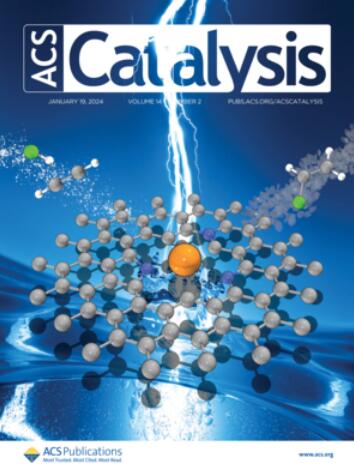Catalytic Hydrogenation of a Ruthenium Carbonyl to Formyl Enabled by Metal–Ligand Cooperation
IF 13.1
1区 化学
Q1 CHEMISTRY, PHYSICAL
引用次数: 0
Abstract
Metal formyl complexes are critical intermediates in the reduction of CO to valuable products such as methanol and higher alcohols/hydrocarbons, yet examples of formyl generation via the catalytic hydrogenation of transition metal carbonyl complexes under mild conditions are lacking. The catalytic hydrogenation of a ruthenium carbonyl complex with H2 to produce a formyl complex is reported here. Two classes of hydrogenation catalysts were compared: bis(diphosphine)-ligated complexes that proceed via termolecular H2 splitting with an external base and pincer-ligated complexes that proceed via an H2 splitting mechanism involving metal–ligand cooperativity. The hydride transfer and H2 splitting steps were evaluated for both classes of catalysts, revealing advantages for catalysts that utilize metal–ligand cooperativity and elucidating conditions to promote formyl generation. Only the pincer-ligated Ir and Ru complexes capable of reacting via pathways involving metal–ligand cooperativity were suitable for catalysis. Using 1–10 mol % of the catalysts (PNP)Ir(H)2 and (HPNP)Ru(H)2(CO) (PNP = (iPr2PC2H4)2N–), which use metal–ligand cooperation to activate H2, up to 10 turnovers or up to 71% yield were achieved for the conversion of [Ru(bpy)2(CO)2]2+ (bpy = 2,2′-bipyridine) to the formyl complex [Ru(bpy)2(CO)(CHO)]+. The Lewis acid B(C6F5)3 was required as an additive to achieve high yields of the formyl complex using (HPNP)Ru(H)2(CO) as a catalyst. The catalytic route avoids the use of expensive stoichiometric reagents, such as borohydride, instead generating metal formyls that are key intermediates in CO reduction schemes with H2 gas.金属-配体协同催化钌羰基加氢制甲酰基
金属甲酰基配合物是将一氧化碳还原为甲醇和高级醇/碳氢化合物等有价值产品的关键中间体,但缺乏在温和条件下通过过渡金属羰基配合物催化加氢生成甲酰基的例子。本文报道了钌羰基配合物与H2催化加氢生成甲酰基配合物。对两类加氢催化剂进行了比较:双(二膦)连接配合物通过与外部碱的三分子H2分裂进行,而钳连接配合物通过涉及金属配体协同性的H2分裂机制进行。对这两类催化剂的氢化物转移和H2分裂步骤进行了评价,揭示了利用金属配体协同作用的催化剂的优势,并阐明了促进甲酰基生成的条件。只有能够通过涉及金属配体协同作用的途径进行反应的钳子连接Ir和Ru配合物才适合催化。使用1-10摩尔%的催化剂(PNP)Ir(H)2和(HPNP)Ru(H)2(CO) (PNP = (iPr2PC2H4)2N -),利用金属配体协同活化H2,将[Ru(bpy)2(CO)2]2+ (bpy = 2,2 ' -联吡啶)转化为甲酰基络合物[Ru(bpy)2(CO)(CHO)]+达到10次翻转或高达71%的产率。需要Lewis酸B(C6F5)3作为添加剂,以(HPNP)Ru(H)2(CO)为催化剂实现甲酰基配合物的高收率。催化途径避免使用昂贵的化学计量试剂,如硼氢化物,而是产生金属甲酰基,这是H2气体CO还原方案的关键中间体。
本文章由计算机程序翻译,如有差异,请以英文原文为准。
求助全文
约1分钟内获得全文
求助全文
来源期刊

ACS Catalysis
CHEMISTRY, PHYSICAL-
CiteScore
20.80
自引率
6.20%
发文量
1253
审稿时长
1.5 months
期刊介绍:
ACS Catalysis is an esteemed journal that publishes original research in the fields of heterogeneous catalysis, molecular catalysis, and biocatalysis. It offers broad coverage across diverse areas such as life sciences, organometallics and synthesis, photochemistry and electrochemistry, drug discovery and synthesis, materials science, environmental protection, polymer discovery and synthesis, and energy and fuels.
The scope of the journal is to showcase innovative work in various aspects of catalysis. This includes new reactions and novel synthetic approaches utilizing known catalysts, the discovery or modification of new catalysts, elucidation of catalytic mechanisms through cutting-edge investigations, practical enhancements of existing processes, as well as conceptual advances in the field. Contributions to ACS Catalysis can encompass both experimental and theoretical research focused on catalytic molecules, macromolecules, and materials that exhibit catalytic turnover.
 求助内容:
求助内容: 应助结果提醒方式:
应助结果提醒方式:


